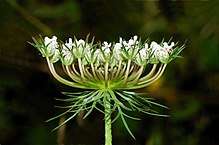Umbel
In botany, an umbel is an inflorescence that consists of a number of short flower stalks (called pedicels) which spread from a common point, somewhat like umbrella ribs. The word was coined in botanical usage in the 1590s, from Latin umbella "parasol, sunshade".[1] The arrangement can vary from being flat-topped to almost spherical. Umbels can be simple or compound. The secondary umbels of compound umbels are known as umbellules[2] or umbellets.[3] A small umbel is called an umbellule.[3] The arrangement of the inflorescence in umbels is referred to as umbellate, or occasionally subumbellate (almost umbellate).
| Look up umbel in Wiktionary, the free dictionary. |
Umbels are a characteristic of plants such as carrot, parsley, dill, and fennel in the family Apiaceae; ivy, Aralia and Fatsia in the family Araliaceae; onion (Allium) in the family Alliaceae.
An umbel is a type of indeterminate inflorescence.[3][4] A compressed cyme, which is a determinate inflorescence, is called umbelliform if it resembles an umbel.
Gallery
- Compound umbel of a hemlock-parsley, Conioselinum pacificum (Apiaceae)
 Compound umbel of a wild carrot, Daucus carota (Apiaceae)
Compound umbel of a wild carrot, Daucus carota (Apiaceae) Simple umbel of Fatsia japonica (Araliaceae)
Simple umbel of Fatsia japonica (Araliaceae).jpg) Involucrate simple umbels of Primula veris.
Involucrate simple umbels of Primula veris.
References
- umbel etymology
- Menglan She, Fading Pu, Zehui Pan, Mark Watson, John F. M. Cannon, Ingrid Holmes-Smith, Eugene V. Kljuykov, Loy R. Phillippe & Michael G. Pimenov. "Apiaceae Lindley". Flora of China. 14. Retrieved 15 January 2019 – via eFloras.org, Missouri Botanical Garden, St. Louis, MO & Harvard University Herbaria, Cambridge, MA.CS1 maint: uses authors parameter (link)
- Beentje, H.; Williamson, J. (2010). The Kew Plant Glossary: an Illustrated Dictionary of Plant Terms. Royal Botanic Gardens, Kew: Kew Publishing.
- Walters, D.R.; Keil, D.J. (1975). Vascular Plant Taxonomy. Dubuque: Kendall/Hunt Publishing Company.
Further reading
- Hinderer, Walter; Noé, Wolfgang; Seitz, Hanns Ulrich (1983). "Differentiation of metabolic pathways in the umbel of Daucus carota". Phytochemistry. 22 (11): 2417–2420. doi:10.1016/0031-9422(83)80131-9. ISSN 0031-9422.
- Toben, H.-M.; Rudoph, K (1996). "Pseudomonas syringae pv. coriandricola, Incitant of Bacterial Umbel Blight and Seed Decay of Coriander (Coriandrum sativum L.) in Germany". Journal of Phytopathology. 144 (4): 169–178. doi:10.1111/j.1439-0434.1996.tb01510.x. ISSN 0931-1785.
- Peterson, L. E.; Clark, R. J.; Menary, R. C. (1993). "Umbel Initiation and Stem Elongation in Fennel(Foeniculum vulgare)Initiated by Photoperiod". Journal of Essential Oil Research. 5 (1): 37–43. doi:10.1080/10412905.1993.9698168. ISSN 1041-2905.